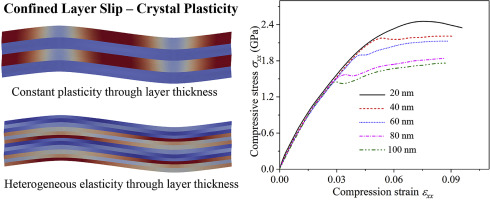当前位置:
X-MOL 学术
›
Int. J. Plasticity
›
论文详情
Our official English website, www.x-mol.net, welcomes your feedback! (Note: you will need to create a separate account there.)
Mesoscale crystal plasticity modeling of nanoscale Al-Al2Cu eutectic alloy
International Journal of Plasticity ( IF 9.8 ) Pub Date : 2019-10-01 , DOI: 10.1016/j.ijplas.2019.06.008 Guisen Liu , Dongyue Xie , Shujuan Wang , Amit Misra , Jian Wang
International Journal of Plasticity ( IF 9.8 ) Pub Date : 2019-10-01 , DOI: 10.1016/j.ijplas.2019.06.008 Guisen Liu , Dongyue Xie , Shujuan Wang , Amit Misra , Jian Wang

|
Abstract Nanolaminated composites composed of alternate metal and intermetallic or ceramic lamellae exhibit high strength, high strain hardening rate and measurable plasticity at ambient and elevated temperatures. Due to the difference in plastic deformation capability between the two phases, structural instability occurs in hard lamellae associated with buckling when a compression strain is applied parallel to the lamellae. Taking nanoscale Al–Al2Cu eutectic alloy as a model system, we develop a mesoscale crystal plasticity (CP) model based on the confined layer slip (CLS) mechanism (referred to as CLS-CP) to understand the buckling behavior of the nanolaminates. In the CLS-CP model, buckling in Al2Cu lamellae is constrained by the elastic-plastic deformation of Al lamellae. The critical resolved shear stress for dislocation slip in Al lamellae varies with layer thickness, estimated by the CLS mechanism. To capture the essential features of confined layer slip mechanism that dislocations propagate within the layer and are deposited at the interfaces, plastic deformation in each lamella is the same through the layer thickness. The variation of elastic deformation through the layer thickness is captured through dividing each Al lamella into three or more elements that have the same plastic deformation through the thickness. In comparison, we also conduct standard crystal plasticity modeling in which plastic deformation in the three elements through the layer thickness is calculated individually according to phenomenological power law. In these simulations, plasticity in Al2Cu lamellae is modeled with slips on {121} planes due to the slip continuity across the interface, which have been observed in our recent experiments. The CLS-CP model is able to predict mechanical properties of nano-scale lamellar materials. In contrast, the standard CP model is more suitable to study deformation behavior of sub-micro scale lamellar materials. The CLS-CP model calculations reveal that critical compression strain corresponding to buckling increases as layer thickness decreases, which agree with micro-pillar compression tests.
中文翻译:

纳米Al-Al2Cu共晶合金的中尺度晶体塑性建模
摘要 由交替金属和金属间化合物或陶瓷薄片组成的纳米层压复合材料在环境温度和高温下表现出高强度、高应变硬化率和可测量的塑性。由于两相之间塑性变形能力的差异,当压缩应变平行于薄片施加时,硬薄片中会发生结构不稳定性与屈曲相关。以纳米级 Al-Al2Cu 共晶合金为模型系统,我们基于受限层滑移 (CLS) 机制 (称为 CLS-CP) 开发了中尺度晶体塑性 (CP) 模型,以了解纳米层压板的屈曲行为。在 CLS-CP 模型中,Al2Cu 薄片的屈曲受到铝薄片的弹塑性变形的约束。铝薄片中位错滑移的临界解析剪切应力随层厚度而变化,由 CLS 机制估计。为了捕捉位错在层内传播并沉积在界面处的受限层滑移机制的基本特征,每个薄片中的塑性变形在整个层厚度上都是相同的。通过将每个 Al 薄片划分为三个或更多个在整个厚度上具有相同塑性变形的元素,可以捕获通过层厚度的弹性变形的变化。相比之下,我们还进行了标准晶体塑性建模,其中根据唯象幂律分别计算三个元素在整个层厚度中的塑性变形。在这些模拟中,由于界面上的滑移连续性,Al2Cu 薄片中的塑性用 {121} 平面上的滑移建模,这在我们最近的实验中已经观察到。CLS-CP 模型能够预测纳米级层状材料的机械性能。相比之下,标准CP模型更适合研究亚微米尺度层状材料的变形行为。CLS-CP 模型计算表明,与屈曲对应的临界压缩应变随着层厚度的减小而增加,这与微柱压缩测试一致。标准CP模型更适合研究亚微尺度层状材料的变形行为。CLS-CP 模型计算表明,与屈曲对应的临界压缩应变随着层厚度的减小而增加,这与微柱压缩测试一致。标准CP模型更适合研究亚微尺度层状材料的变形行为。CLS-CP 模型计算表明,与屈曲对应的临界压缩应变随着层厚度的减小而增加,这与微柱压缩测试一致。
更新日期:2019-10-01
中文翻译:

纳米Al-Al2Cu共晶合金的中尺度晶体塑性建模
摘要 由交替金属和金属间化合物或陶瓷薄片组成的纳米层压复合材料在环境温度和高温下表现出高强度、高应变硬化率和可测量的塑性。由于两相之间塑性变形能力的差异,当压缩应变平行于薄片施加时,硬薄片中会发生结构不稳定性与屈曲相关。以纳米级 Al-Al2Cu 共晶合金为模型系统,我们基于受限层滑移 (CLS) 机制 (称为 CLS-CP) 开发了中尺度晶体塑性 (CP) 模型,以了解纳米层压板的屈曲行为。在 CLS-CP 模型中,Al2Cu 薄片的屈曲受到铝薄片的弹塑性变形的约束。铝薄片中位错滑移的临界解析剪切应力随层厚度而变化,由 CLS 机制估计。为了捕捉位错在层内传播并沉积在界面处的受限层滑移机制的基本特征,每个薄片中的塑性变形在整个层厚度上都是相同的。通过将每个 Al 薄片划分为三个或更多个在整个厚度上具有相同塑性变形的元素,可以捕获通过层厚度的弹性变形的变化。相比之下,我们还进行了标准晶体塑性建模,其中根据唯象幂律分别计算三个元素在整个层厚度中的塑性变形。在这些模拟中,由于界面上的滑移连续性,Al2Cu 薄片中的塑性用 {121} 平面上的滑移建模,这在我们最近的实验中已经观察到。CLS-CP 模型能够预测纳米级层状材料的机械性能。相比之下,标准CP模型更适合研究亚微米尺度层状材料的变形行为。CLS-CP 模型计算表明,与屈曲对应的临界压缩应变随着层厚度的减小而增加,这与微柱压缩测试一致。标准CP模型更适合研究亚微尺度层状材料的变形行为。CLS-CP 模型计算表明,与屈曲对应的临界压缩应变随着层厚度的减小而增加,这与微柱压缩测试一致。标准CP模型更适合研究亚微尺度层状材料的变形行为。CLS-CP 模型计算表明,与屈曲对应的临界压缩应变随着层厚度的减小而增加,这与微柱压缩测试一致。



























 京公网安备 11010802027423号
京公网安备 11010802027423号